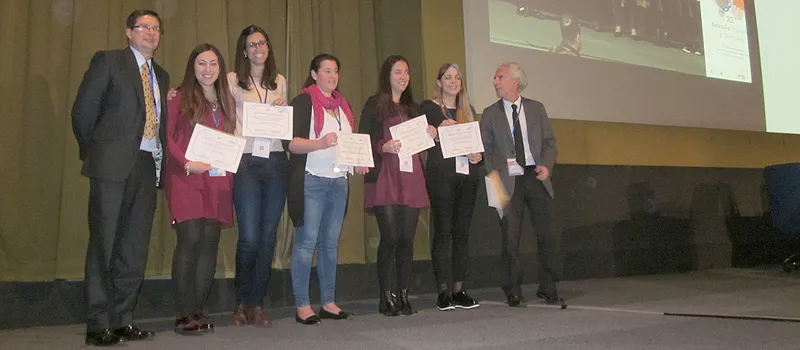Six resident internal doctors (MIR) have deserved two awards for their clinical cases of type II diabetes mellitus, which have spread as a brooch of the meeting on the disease of the semi.One of them, the sixth winner, has presented a job with 19 patients as the rest of a single patient.
This way of presenting cases from a person "is always endowed with great educational value, not so much scientific, which already requires elaborating an essay," the internist of the Costa del Sol de Marbella hospital has nuanced medical writing (Málaga (Málaga (Málaga) Javier García Alegría, who has coordinated the contest addressed to the MIR.
Thus, the internal resident of the Jorge de Huesca Hospital Carmen Jimeno Griño (First Prize) has received the Distinctive of the SEMI to one of the six best communications, in the contest on clinical cases organized by the Scientific Society, for its work SGLT2,A step prior to bariatric surgery.
All winning residents pose together with Javier Ena and Ricardo Gómez, coordinators of the meeting.
It has followed a 57 -year -old patient with diabetes of a decade of evolution, 108 kilograms of weight and a body mass index (BMI), from 37. He managed to reduce the BMI to 32 as a previous action as previous action, even sometimes substitute, from passing through the operating room.
Likewise, Mir Cristina Saval Segura, from the Sacred Heart Hospital of Barcelona, has seen its liraglutida case, beyond the glycemic control, in which he describes a 48 -year -old patient with diabetes and obesity who, in this case, was subjectedto bariatric surgery and that, with the treatment, managed to reduce the weight of 106 kilograms to only 69, although after ten years he stayed in the 85 (but with good metabolic control at all times).
Third, the resident Alba Rodríguez Pérez, of the Doctor Negrín Hospital in Gran Canaria, has deserved the recognition of the SEMI in the case of a 49 -year -old woman with obesity, diabetes, diverse cardiovascular risk factors and high resistance to treatment for treatment for treatment forblood pressure.
The original of this case is that it was also diagnosed with sleep.When correcting it with a night device for positive oxygen pressure control (CPAC), it lowered its weight of 112 initial kilograms to 98 with the treatment, in addition to achieving adequate control of both its diabetes and its arterial hypertension.
From the title cetaceosis diabetic dizzlemic diabetic as a complication associated with the treatment with packaging, the Mir Teresa Carrasquer Pirla, of the hospital complex of Navarra (together with other resident colleagues of the Queen Sofía de Tudela), makes this complication known to the use of an antidiabetic, very rarely frequent on the other hand (hence, also, its pedagogical value).
Likewise, Julia Fernández Soto (Fourth Award), of the Huelva Hospital Complex, has deserved another of the semi awards for his severe resistance case, a simple and cheap management, in which the case of a patient is explained61 years old with 38 evolution of the disease and 101 kilograms of weight.
This work finds its originality in which it was the change of the insulin administered (argina in a different concentration) that managed to control the picture of the disease, including the patient's weight (28 kilograms less starting from 101).
The patient needed, specifically, 275 units per day of insulin with Argina of 100;When changing it for another formula of the same substance, but 300 concentration, it found that general improvement with optimal disease control.
Finally, the CANA study: if there is no “risk”, does not win, by Marta Sáenz de Tejada (fifth prize), Mir of the Infanta Elena de Huelva hospital, in effect documentary 19 cases and values in them the impact of aDrug, the canalifozin, which improves diabetic control and decrease the BMI.


